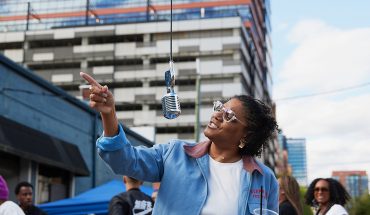The Raleigh Rockers bring the beat
by Ayn-Monique Klahre | photography by Gus Samarco

If you’re lucky, you’ve encountered the Raleigh Rockers already: Spinning and doing one-handed flips, egging each other on as they go from one impossible move to the next. The group—individually, they’re called beat boys and beat girls—started in 2007 as a club at N.C. State, and slowly grew to include non-students. The eclectic mix of members combine raw talent and creativity with loads of practice; the breakdancing crew may not dance as their full-time jobs, but it sure does look like it. The current group has twelve members, and a handful of the originals remain including Dillon Carter, Andrew Ngo and John Galloway. The Rockers evolved from a school club to a true crew around 2010, when the group decided to “take it to the next level,” says member Brandon McCrimmon, by battling other crews out of state.

The Raleigh Rockers get together a few times a week to train together—usually in the Warehouse District at CAM—and McCrimmon (known as Beat Boy No Sense for a move involving spinning on his head) is quick to say that anyone is welcome to sit in on practice or join the dance. All year long, the group battles in competitions and for fun, judges other breakdancing competitions and teaches classes for a mix of learning, rehearsing and sharing their talents.

The key to breakdancing, McCrimmon says, is to see what others are doing, but to invent your own style. “You do not want to copy, you want to be original in your own movement and personality.” When you copy someone, that’s called “biting,” and onlookers will not hesitate to call you out. “The biggest thing is to be yourself,” says McCrimmon.
Overall, the spirit of breakdancing is one of friendly competition. “There’s always someone doing something tougher, or something with more style,” he says, and that compels them to work harder. Even now—much like breakdancing’s origins in the Bronx in the late 1970s—some of his biggest inspiration comes from kids as young as five who make up their own moves and share them on YouTube. “To see kids still loving this dance is awesome—I always say that the dance chooses you,” says McCrimmon.

In addition to training and participating in battles against crews all over the U.S., the Raleigh Rockers hold workshops for kids and adults at venues like Arts Together, pop up at music festivals and participate in city events. The group’s upbeat energy can win over even the most shy or skeptical audience member—something I witnessed myself recently when the Rockers were special guests at Conn Elementary School’s winter dance. Within minutes of turning on the music, they had dozens of grade schoolers (and more than a few parents, too) on their feet learning moves with great enthusiasm. Both the sense of play and inclusivity are fundamental to the breakdancing practice. “My main goal is to motivate and inspire,” says McCrimmon. “If I can make someone smile when I dance, my job is done.”



